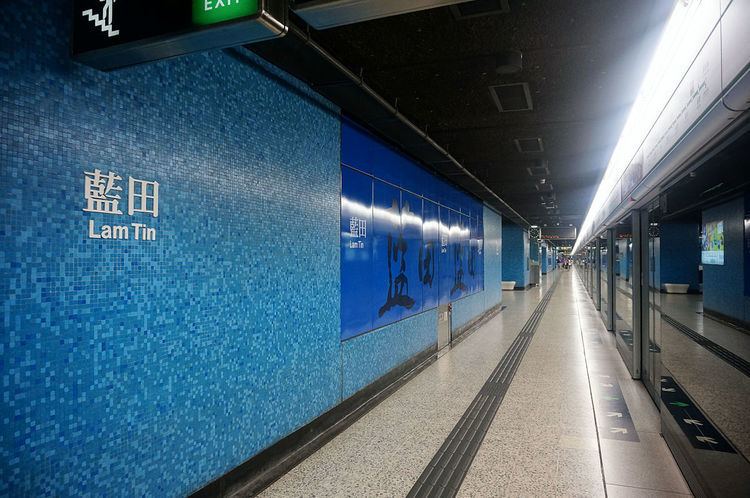Traditional Chinese 藍田 Cantonese Yale Làamtìn Literal meaning Blue field Opened 1 October 1989 | Simplified Chinese 蓝田 Hanyu Pinyin Hanyu Pinyin Level 1 | |
 | ||
Address Sceneway Garden, Hong Kong Similar Yau Tong Station, Lok Fu Station, Shek Kip Mei Station, Quarry Bay Station, Ngau Tau Kok Station | ||
Lam tin station in hk mtr
Lam Tin (Chinese: 藍田; Cantonese Yale: Làamtìn) is a station on the Hong Kong MTR Kwun Tong Line built as a part of the extension to Quarry Bay. The station is linked to the hillside community of the Lam Tin area by a series of escalators.
Contents
- Lam tin station in hk mtr
- Mtr ktl c train entering and leaving lam tin station
- History
- Station layout
- Entrancesexits
- Transport connections
- References
Mtr ktl c train entering and leaving lam tin station
History
In the 1980s, the Eastern Harbour Crossing (EHC or EHT) was planned by the colonial government. Following the successful performance of the MTR since 1978, the government decided to extend the Kwun Tong Line through a new tunnel to Quarry Bay.
It was later decided that before the entrance to the tunnel, trains would stop at a station in the Lam Tin Valley, where it goes into the Sai Tso Wan Hill and then underground to the entrance of the tunnel.
The station was opened in October 1989. As part of his official visit with then Princess of Wales to Hong Kong, the Prince of Wales officiated the opening of the station, in which a commemorative plaque remains on display to this day.
After the opening of the EHC, Lam Tin, with the MTR station and bus terminals, became a crucial transport interchange in east Kowloon. The station serves passengers between Tseung Kwan O and other parts of Kowloon as well as between Hong Kong and Kowloon.
Platform screen doors have been in use since late August 2005.
Station layout
Platforms 1 and 2 share the same island platform. Like Lai King Station, Lam Tin Station is built on an elevated platform, in which half of the platform is immersed into the Lam Tin Hill and so the station is sealed like other underground stations (but it is mixed as an elevated, ground level, and underground station).
The concourse is the first floor down the escalators from the hillside exits. It is divided into two parts: the paid area and the non-paid area. The paid area has escalators down to the platforms and has a postbox, while the non-paid area links the exits and houses a Hang Seng Bank branch.
Between the paid and non-paid areas there are the entrance gates and a customer service centre which serves both areas.
Entrances/exits
The station offers, on a trial basis, an accessible car service for passengers using wheelchairs. On demand, the service will transport the passengers from either exit A or D1 to exit C, which is accessible.
Transport connections
Following the MTR station's opening in 1989, the area around Lam Tin Station has been developed into a major transportation interchange in Hong Kong. The shopping centre and Sceneway Plaza above the transportation interchange adjacent to the station were built on a site that used to be occupied by a hillside squatter village.
The original Lam Tin community has also seen several rebuilding projects since the station had been built. The interchange has brought in new residential and commercial demand in the community. The bus termini, the Lei Yue Mun Interchange, and other public transportation facilities had transformed the Lam Tin area into an important transportation hub as well as a commercial and residential centre.
These routes terminate at the Lam Tin MTR Bus Terminus:
